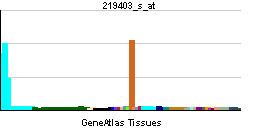Entrez 10855 | Ensembl ENSG00000173083 | |
 | ||
Aliases HPSE, HPA, HPA1, HPR1, HPSE1, HSE1, heparanase External IDs MGI: 1343124 HomoloGene: 68528 GeneCards: HPSE | ||
Heparanase, also known as HPSE, is an enzyme that acts both at the cell-surface and within the extracellular matrix to degrade polymeric heparan sulfate molecules into shorter chain length oligosaccharides.
Contents
Synthesis and structure
The protein is originally synthesised in an inactive 65 kDa proheparanase form in the golgi apparatus and transferred to late endosomes/lysosomes for transport to the cell-surface. In the lysosome it is proteolytically processed into its active form. Proteolytic processing results in the production of three products,
The 8 kDa and 50 kDa fragments form a heterodimer and it is this heterodimer that constitutes the active heparanase molecule. The linker protein is so called because prior to its excision it physically links the 8 kDa and 50 kDa proheparanase fragments. Complete excision of the linker peptide appears to be a prerequisite to the complete activation of the heparanase enzyme.
Function
Heparanase has endoglycosidase activity and cleaves polymeric heparan sulfate molecules at sites which are internal within the polymeric chain. In ocular surface physiology this activity functions as an off/on switch for the prosecretory mitogen lacritin. Lacritin binds the cell surface heparan sulfate proteoglycan syndecan-1 only in the presence of active heparanase. Heparanase partially or completely cleaves heparan sulfate to expose a binding site in the N-terminal 50 amino acids of syndecan-1.
Clinical significance
The successful penetration of the endothelial cell layer that lines the interior surface of blood vessels is an important process in the formation of blood borne tumour metastases. Heparan sulfate proteoglycans are major constituents of this layer and it has been shown that increased metastatic potential corresponds with increased heparanase activity for a number of cell lines. Due to the contribution of heparanase activity to metastasis and also to angiogenesis, the inhibition of heparanase activity it is considered to be a potential target for anti-cancer therapies.
Heparanase has been shown to promote arterial thrombosis and stent thrombosis in mouse models due to the cleavage of anti-coagulant heparan sulfate proteoglycans.
